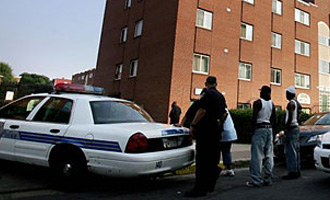
|  |  |  Editorials | Issues | July 2009 Editorials | Issues | July 2009  
The US Drug War's Wrong Focus
 Robert Weiner & Zoe Pagonis - Baltimore Sun Robert Weiner & Zoe Pagonis - Baltimore Sun
go to original
July 27, 2009


| | Baltimore police pull over a car to perform a drug check. Despite evidence that heavy law enforcement does not solve drug-related problems, the drug war rages on. (AFP/Getty Images) |  |
When it comes to treatment, the White House should put its money where its mouth is.

In Baltimore last week, new U.S. drug czar Gil Kerlikowske made the case for expansion of drug courts to treat rather than imprison addicts and called for drugs to be considered a "public health crisis."

Why, then, is the Obama administration proposing to spend an even higher percentage of its anti-drug resources on law enforcement than the administration of George W. Bush?

Nowhere are these issues more resonant than in Baltimore. Felicia "Snoop" Pearson, a star of HBO's The Wire and a native of the city, said that her mother stole clothes off of her body for drug money and locked her in a closet. Darius Harmon, an 18-year-old learning-disabled boy from Baltimore, was killed in April by the Black Guerrilla Family gang because he was not good at selling drugs. Despite recent progress, the Drug Enforcement Administration in March found that Baltimore still has more drug-related crime than any other city in the nation.

Mr. Kerlikowske has said, "It is only through a balanced approach - combining tough but fair enforcement with robust prevention and treatment - that we will be successful in stemming both demand and supply of illegal drugs." Yet, in the 2010 budget, there is a 3.3 percent reduction in treatment and prevention initiatives since 2008, exacerbating the bias toward enforcement, which now represents 65.6 percent of the budget, even higher than the last administration's 62.3 percent.

With 20.8 million Americans needing treatment but unable to get it - by some estimates, 30,000 in Baltimore alone - Congress should double the $5 billion currently budgeted for prevention and treatment. If we can spend $6 trillion to shore up our financial institutions and a trillion on Iraq (only to discover that al-Qaeda is actually in Afghanistan), increasing drug treatment to stop the main catalyst of crime and save families would be an extraordinarily rational policy shift.

Treatment is cost-effective. According to a study commissioned by the U.S. Army, for every dollar invested in drug treatment, taxpayers save upward of $7 in crime-related reductions due to less incarceration and hospitalization. This $5 billion investment thus translates to real savings of $35 billion for American taxpayers.

Participants in the Baltimore City Drug Treatment Court were re-arrested 34.5 percent fewer times than other offenders, and the court found a 36 percent return on the initial $8 million investment. The federal government should extend drug courts to every possible community.

Ron Hunsicker, President of the National Association of Addiction Treatment Providers, agrees Congress must increase treatment funding but cautions that we must not allow insurance companies to just "shift the cost to the federal government" and that treatment must cover "not just an acute model but chronic care" to stop recidivism. Both Hunsicker and former Drug Czar Barry McCaffrey agree that drug treatment must be included in the pending national health insurance reforms.

Enforcement initiatives certainly have their place. Baltimore experienced a 9 percent decrease in overall crime over the past year, thanks to a $13.9 million boost in police force funding, D.C.-Baltimore regional cooperation, a drug bust involving 70 arrests and participation in the federal High Intensity Drug Trafficking Area program. The point here is not to disparage law enforcement - a key part of the very real reductions in national crime and drug statistics - but to add to essential treatment efforts that will get at the rest of the remaining serious problem.

According to the Justice Department this May, 68 percent of arrestees in 10 cities tested positive for illegal drugs. As long as there are addicts and drug abusers, people will buy and sell drugs.

Maryland Democratic Congressman Elijah Cummings, chairman of the Congressional Drug Caucus, asserted, "Drug abuse and related violence have destroyed whole generations in our community." Gov. Martin O'Malley agreed, noting, "It is our obligation to ensure adequate treatment." Ted Gest, president of Criminal Justice Journalists, states in his book, Crime and Politics, "Tough law enforcement usually wins out because it is easier to put into motion, quantify and explain to the public."

President Barack Obama is right to increase the National Drug Control budget by $224.3 million, but the focus is not where it's needed most. If they really want to stop crime and prevent addiction, the administration and Congress need to give prevention and treatment programs far more standing in the nation's drug control budget.

Robert Weiner is former spokesman for the White House National Drug Policy Office. Zoe Pagonis, policy analyst at Robert Weiner Associates, was a 2008 Maryland Governor's Citation recipient for policy development. They may be reached at weinerpublic(at)comcast.net. |

 |
|  |



